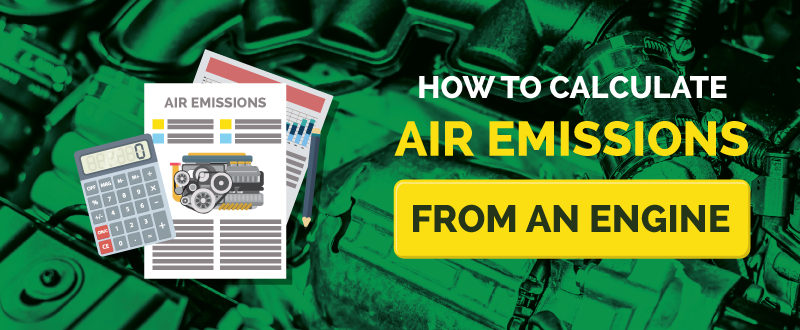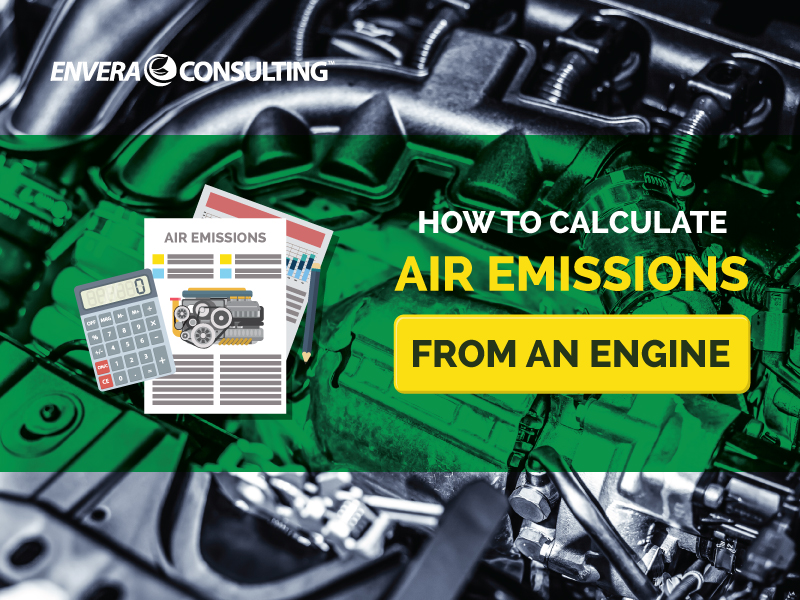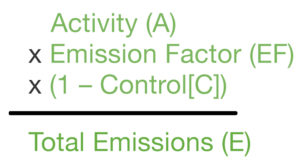

The following text is an abridged and edited transcript of the video that follows at the end of this post.
With annual emissions reports due in just a few weeks, we know that many of you are racing to calculate air emissions from any engines that might be in your facilities. To help you out, we’ve outlined the four steps to take when calculating emissions from an internal combustion engine (ICE).
But first, it helps to understand the formula so you know what pieces of information to collect and how those pieces will be used. As we previously discussed, there’s a general formula for calculating air emissions for any piece of equipment. Equipment emissions is equal to the activity of that piece of equipment multiplied by the emission factor for that piece of equipment, multiplied by the efficiency of any control devices that may be present or relevant to that piece of equipment subtracted from 1. So the formula reads:

The post mentioned above goes into those components in more detail, so we’ll skip right to the meat of the matter.
The Utility of Unit Conversions [05:50]
Depending on the kind of data you’re given, you’ll have to do some conversions, as well as a little homework to know what else you need to use the data provided.
The type of conversions depends on three things:
- What kind of data you’re looking for
- What kind of data is collected in the field
- What kind of units you want at the end
Field data rarely comes in a nice, neat package. You may ask for data to be represented in terms of volume and instead get it in terms of time. For example, you may ask how many gallons of diesel the B4 generator used last year, but the operator reports back that it operated for 29.5 hours — the operation time, rather than the fuel volume. Depending on how well you know how to convert, that information may not work for you, or you may have to ask follow-up questions.
Another example of converting data would be extrapolating for a time period. For example, you may tell the plan engineer you need the amount of diesel consumed by an engine last calendar year, only to hear that five gallons were used in July. You have to go back and synthesize all of the information to determine what you’re going to do with it.
The point is that field data will come in different units, different time frames, and different parameters. You, as a professional, need to know how to convert all of this data to usable form so that you can plug it into the equation.
To do that, you must know what you have and what’s needed. To convert the data into usable form, sometimes you may need to use an operating schedule. You may need to use an equipment specification like an engine rating. You may need to know conversions and engineering assumptions.
Like I said, the data is going to come in all different types, time periods, and units, and one of the biggest mistakes people make when calculating air emissions is not cancelling out the units. In that case, you could end up with higher than normal emissions, which could cause problems.
If you’re using this data on your annual emission report (AER), the end number needs to be expressed in pounds per year. If you’re doing permitting, on the other hand, it may be pounds per hour, pounds per day, or pounds per year, and you may need different units, which will require you to use different conversions.
There are four steps to calculate emissions from your engine, and we’re going to use them as a road map. When we look at the general equation for an emission calculation, some people go left to right and say, “Let me find the activity first, then I’ll get the emission factor, and then we get the control.”
At face value, it may seem like direction doesn’t matter. You could start from the left or the right. We’re going to start in the middle, and I’m going to explain why that’s one of the best things you can do to make it less confusing.
Step 1: Analyze the Emission Factor [11:22]
We highly encourage you to start with the emission factor (EF) when gathering data, because it helps you know right off the bat what units you need for the activity (the control is unit-less) so the two can cancel out. As an example, if you find an emission factor that’s grams per brake horsepower hour (g/bhp-hr), you need to know the engine size as well as the operating time to get the units to work.
On the other hand, if you’re given pounds per gallon, you know the activity you need is in terms of fuel volume. Or, if you’re presented with a concentration, you convert it to a mass per volume emission factor (done using EPA Method 19, commonly referred to as the “dry F factor conversion”).
Once you know the units you’ll be working with, you can move onto the next step.
Step 2: Determine the Units of the Activity Term [14:56]
You now know the units you need for your activity, which you can ask for. Let’s say the units are grams per brake horsepower hour. When you speak to the facility engineer, say you need the size of the engine in those units, as well as the operating time of the engine for 2015.
Even if you’ve done all of your homework, you can still run into problems with incorrect units. For example, you might have a diesel-engine emergency generator whose emission factor is expressed in pounds per gallon. But when you ask the facility engineer for the engine’s fuel consumption data, you might just be given the operating time. That’s because SCAQMD Rule 1470 requires facilities to keep hourly operating logs for emergency generators, so the engineer will merely refer to the logs.
Then what do you do? To get the volume from an operating time, you need to know the brake-specific fuel consumption, which can often be found online or in the manufacturer’s documentation. Sometimes, however, that information might not be easy to simply look up.
We have a trick to use in such cases, but it should be used with discretion: In the absence of brake-specific fuel consumption for a diesel ICE, you can multiply the engine rating in brake horsepower by five percent. That will give you a rough gallons-per-hour factor, which you can then use to convert the operating time to the volume you need.
Step 3: Determine the Control Efficiency [19:09]
To determine the control factor, you’ll have to look at the data that was used to develop the emission factor. That will tell you if the emission factor is a controlled or an uncontrolled value. For engines, the provided emission factor is often a controlled value, but that’s not a hard and fast rule. The control factor in this equation will be one because the emission factor and the control factor are lumped together — but that’s not always the case. For example, if you have an external control device, like an SCR (selective catalytic reduction), connected to your engine, you’ll need to know the control value for the device, which can often be found on the equipment’s permit.
Sometimes you’re going to have to look at the engine and at the permit. When you go to look at the engine, we recommend following the exhaust piping and asking a lot questions about things you see — What’s that device? What’s this device? What’s that over there? — to help you determine what, if any, control device is connected to the engine.
Once you know the control value, subtract that from 1 and you have the overall control factor.
Step 4: Crunch the Numbers [20:55]
You’ve already done the heavy lifting in this project. Now al that remains is to plug the data you’ve gathered into the formula above.
And you’re done!
There you have it — four steps to calculate emissions from an ICE. If you have any questions, you can reach out to us at Envera Consulting.